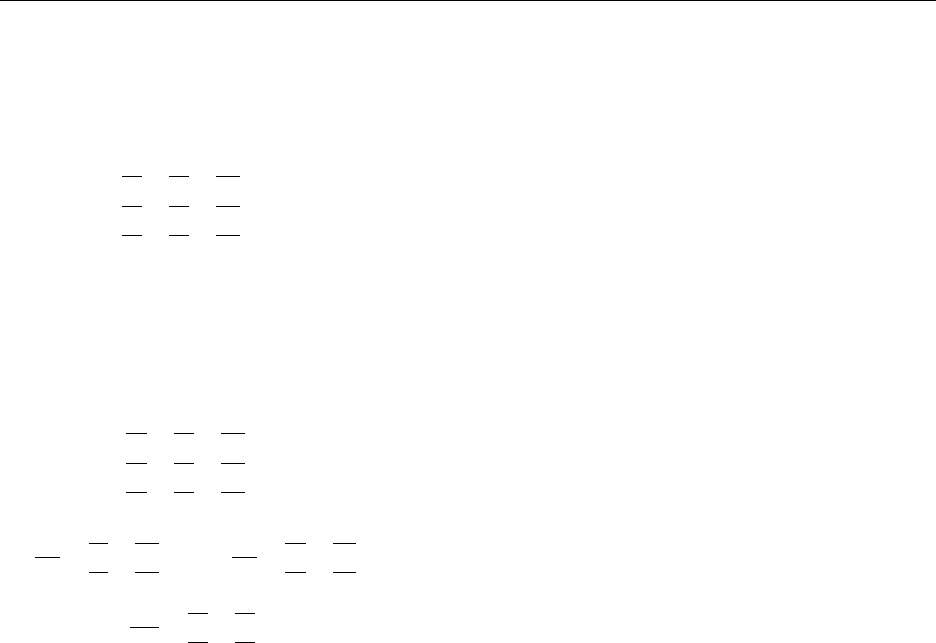
Dr. Z’s Math251 Handout #15.9 [Change of Variables in Multiple Integrals]
By Doron Zeilberger
Problem Type 15.9a: Find the Jacobian of the transformation
x = g(u, v, w) , y = h(u, v, w) , z = k(u, v, w).
Example Problem 15.9a: Find the Jacobian of the transformation
x = u
2
v , y = v
2
w , z = w
2
u.
Steps Example
1. Compute all the entries in the Jaco-
bian matrix
∂x
∂u
∂x
∂v
∂x
∂w
∂y
∂u
∂y
∂v
∂y
∂w
∂z
∂u
∂z
∂v
∂z
∂w
.
1.
2uv u
2
0
0 2vw v
2
w
2
0 2uw
.
2. Evaluate the determinant:
∂x
∂u
∂x
∂v
∂x
∂w
∂y
∂u
∂y
∂v
∂y
∂w
∂z
∂u
∂z
∂v
∂z
∂w
= (
∂x
∂u
)
∂y
∂v
∂y
∂w
∂z
∂v
∂z
∂w
− (
∂x
∂v
)
∂y
∂u
∂y
∂w
∂z
∂u
∂z
∂w
+(
∂x
∂w
)
∂y
∂u
∂y
∂v
∂z
∂u
∂z
∂v
2.
= 2uv
2vw v
2
0 2wu
− u
2
0 v
2
w
2
2wu
+0 ·
0 2vw
w
2
0
= 2uv[(2vw)(2uw)−0]−u
2
[0−(v
2
)(w
2
)]+0
= 9u
2
v
2
w
2
.
Ans.: 9u
2
v
2
w
2
.
Problem Type 15.9b: Use the given transformation to evaluate the integral
Z Z
R
F (x, y) dA ,
where R is the triangular region with vertices (p
1
, p
2
),(q
1
, q
2
), (r
1
, r
2
); x = au + bv, y = cu + dv.
1

Example Problem 15.9b: Use the given transformation to evaluate the integral
Z Z
R
(x + y) dA ,
where R is the triangular region with vertices (0, 0),(2, 1), (1, 2); x = 2u + v, y = u + 2v.
Steps Example
1. Figure out the region in the uv-plane
that gets transformed. Since a triangle
goes to a triangle, we need to find the 3
vertices. Solve for u, v in terms of x, y
and find the three points. Call the new
triangle R
0
.
1. Since x = 2u + v, y = u + 2v, when
(x, y) = (0, 0) u = 0, v = 0 so the point
(0, 0) goes to the point (0, 0). When (x, y) =
(1, 2), we have to solve the system 1 =
2u+v, 2 = u+2v giving us u = 0, v = 1 so
(1, 2) goes to (0, 1). Similarly, (2, 1) goes
to (1, 0). So the region in the uv-plane
is the far simpler triangle whose vertices
are (0, 0), (1, 0), (0, 1). Let’s call this re-
gion R
0
.
2. Find the Jacobian of the transforma-
tion. In this case of a so-called linear
transformation, the Jacobian is simply ad−
bc. Also express F (x, y) in terms of (u, v)
using the transformation.
Z Z
R
F (x, y) dA =
Z Z
R
0
F (au + bv, cu + dv)(ad − bc) dA .
2. The Jacobian is (2)(2) − (1)(1) = 3, so
Z Z
R
(x+y) dA =
Z Z
R
0
(2u+v+u+2v)·3 dA =
9
Z Z
R
0
(u + v) dA .
2

3. Draw the region (in this case triangle)
in the uv- plane and express it as a type
I (or type II) region. Then set-up the ap-
propriate iterated integral, by deciding on
the main road and the side streets.
3. The region is the triangle bounded by
the axes and the line u + v = 1. It can be
written as
{(u, v) | 0 ≤ u ≤ 1 , 0 ≤ v ≤ 1 − u } .
Our area-integral is thus equal to the it-
erated integral
9
Z
1
0
Z
1−u
0
(u + v) dv du .
The inner integral is
Z
1−u
0
(u + v) dv = uv +
v
2
2
1−u
0
= u(1 − u) +
(1 − u)
2
2
= (1 − u
2
)/2 ,
and the whole integral is
9
2
Z
1
0
(1−u
2
) du =
9
2
u −
u
3
3
1
0
=
9
2
·
2
3
= 3 .
Ans.: 3.
3
